BSS064-6: Organizational Culture Analysis of Drax (UK) Limited
VerifiedAdded on 2022/11/15
|10
|2086
|54
Report
AI Summary
This report provides an analysis of the organizational culture of Drax (UK) Limited, focusing on its two subsidiaries, Drax Services and Drax Technology. The report utilizes the cultural web framework to identify key elements of the organizational culture, including stories, rituals, symbols, structure, control systems, and power dynamics. It examines the differences in culture between the two subsidiaries and the impact of leadership on performance. The report also explores change management strategies, including the Change Management Kaleidoscope and Lewin's change model, to align the organizational culture of Drax Services with the overall goals of Drax (UK) Limited. Recommendations include employee training and mentoring to embrace changes and foster a more dynamic and technologically advanced operational environment. The report references various academic sources to support its findings and recommendations.
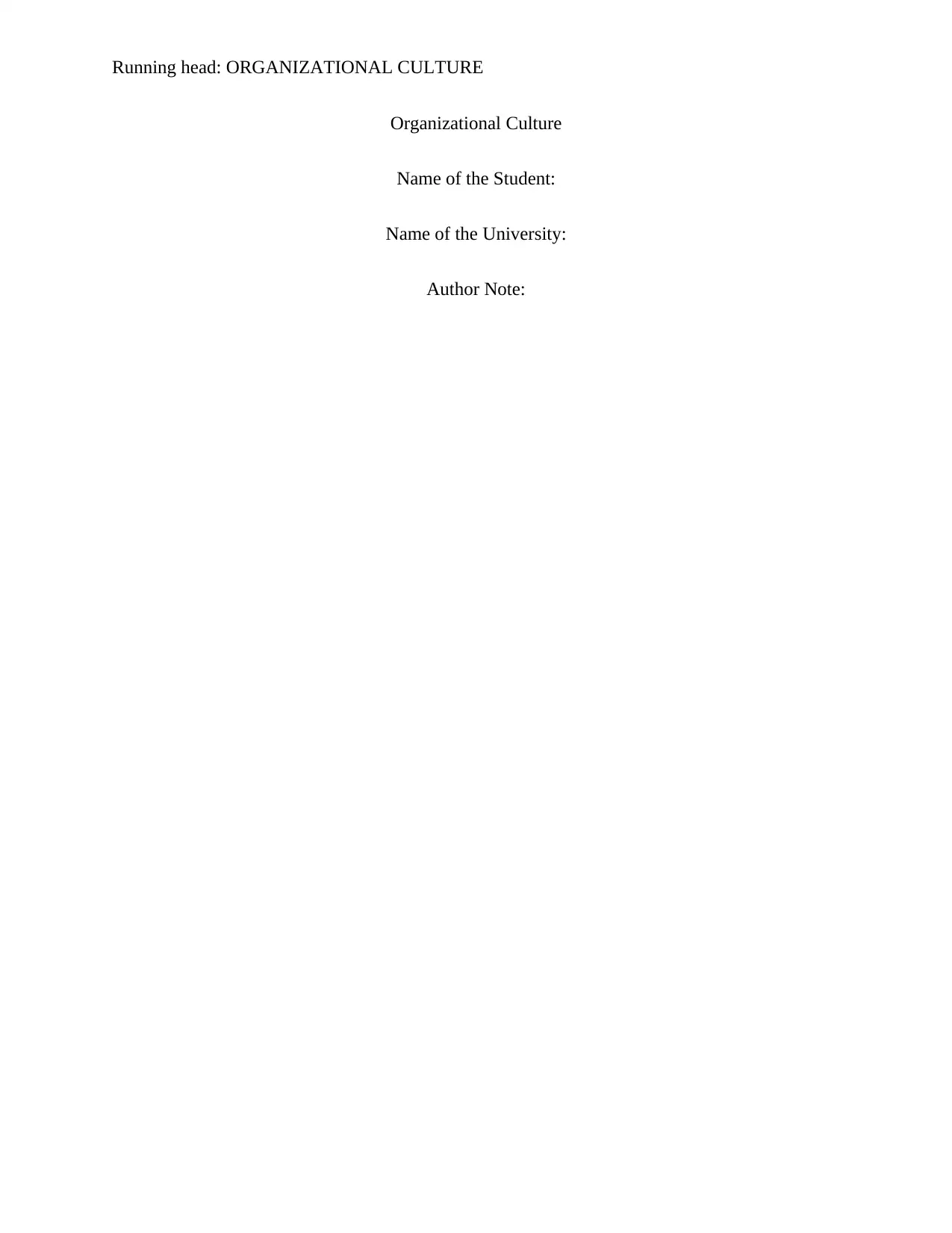
Running head: ORGANIZATIONAL CULTURE
Organizational Culture
Name of the Student:
Name of the University:
Author Note:
Organizational Culture
Name of the Student:
Name of the University:
Author Note:
Paraphrase This Document
Need a fresh take? Get an instant paraphrase of this document with our AI Paraphraser
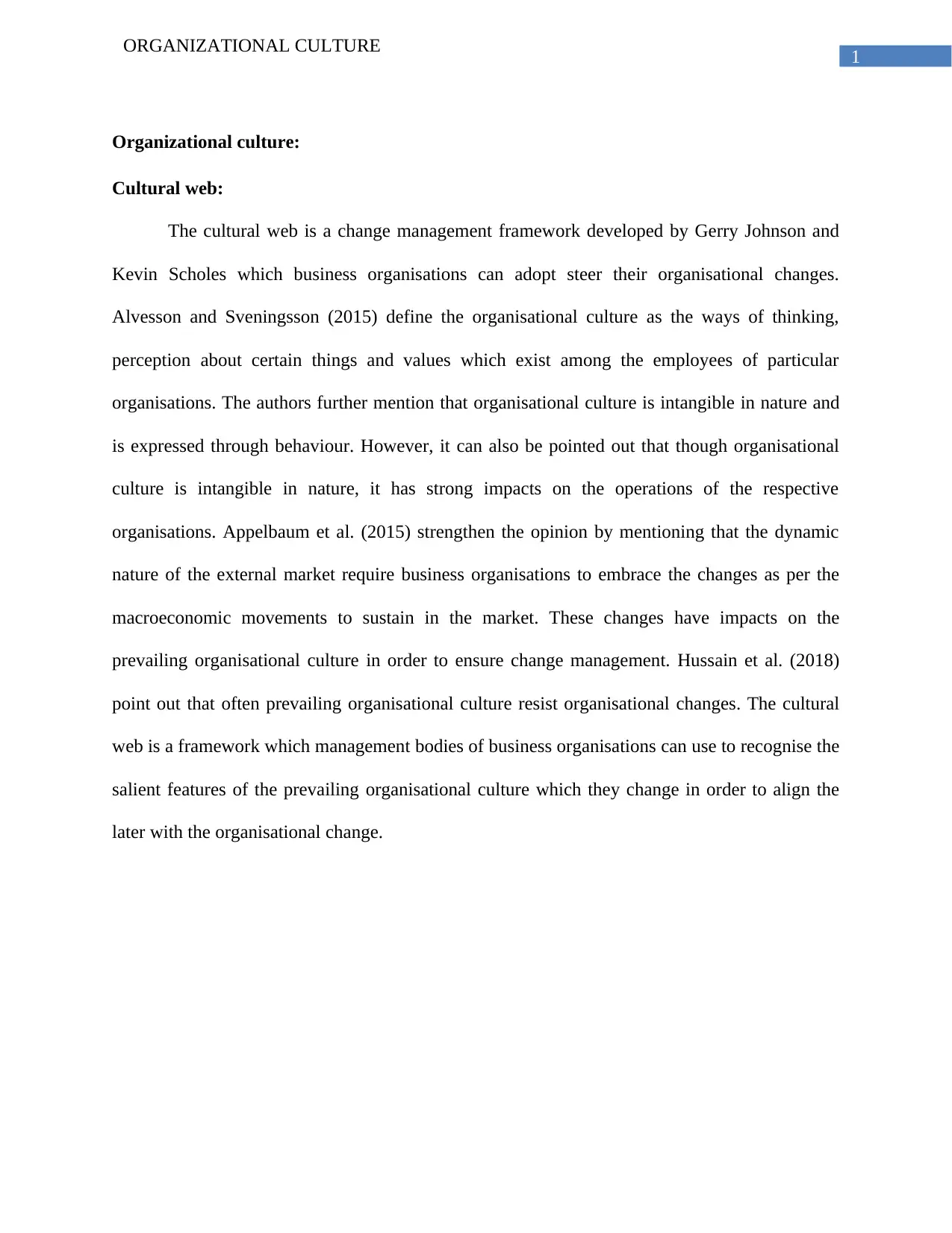
1
ORGANIZATIONAL CULTURE
Organizational culture:
Cultural web:
The cultural web is a change management framework developed by Gerry Johnson and
Kevin Scholes which business organisations can adopt steer their organisational changes.
Alvesson and Sveningsson (2015) define the organisational culture as the ways of thinking,
perception about certain things and values which exist among the employees of particular
organisations. The authors further mention that organisational culture is intangible in nature and
is expressed through behaviour. However, it can also be pointed out that though organisational
culture is intangible in nature, it has strong impacts on the operations of the respective
organisations. Appelbaum et al. (2015) strengthen the opinion by mentioning that the dynamic
nature of the external market require business organisations to embrace the changes as per the
macroeconomic movements to sustain in the market. These changes have impacts on the
prevailing organisational culture in order to ensure change management. Hussain et al. (2018)
point out that often prevailing organisational culture resist organisational changes. The cultural
web is a framework which management bodies of business organisations can use to recognise the
salient features of the prevailing organisational culture which they change in order to align the
later with the organisational change.
ORGANIZATIONAL CULTURE
Organizational culture:
Cultural web:
The cultural web is a change management framework developed by Gerry Johnson and
Kevin Scholes which business organisations can adopt steer their organisational changes.
Alvesson and Sveningsson (2015) define the organisational culture as the ways of thinking,
perception about certain things and values which exist among the employees of particular
organisations. The authors further mention that organisational culture is intangible in nature and
is expressed through behaviour. However, it can also be pointed out that though organisational
culture is intangible in nature, it has strong impacts on the operations of the respective
organisations. Appelbaum et al. (2015) strengthen the opinion by mentioning that the dynamic
nature of the external market require business organisations to embrace the changes as per the
macroeconomic movements to sustain in the market. These changes have impacts on the
prevailing organisational culture in order to ensure change management. Hussain et al. (2018)
point out that often prevailing organisational culture resist organisational changes. The cultural
web is a framework which management bodies of business organisations can use to recognise the
salient features of the prevailing organisational culture which they change in order to align the
later with the organisational change.
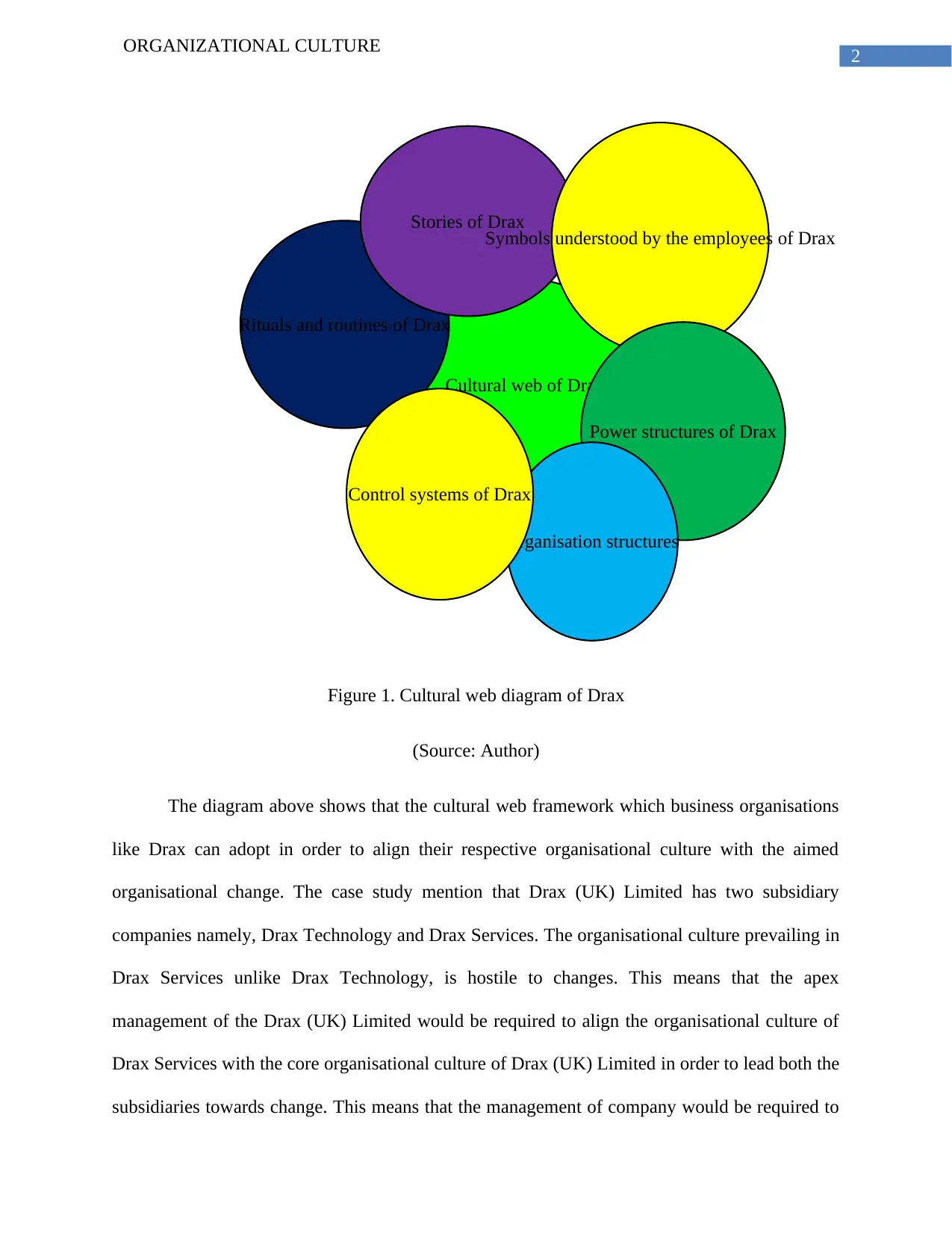
2
ORGANIZATIONAL CULTURE
Cultural web of Drax
Rituals and routines of Drax
Stories of Drax
Symbols understood by the employees of Drax
Power structures of Drax
Organisation structures
Control systems of Drax
Figure 1. Cultural web diagram of Drax
(Source: Author)
The diagram above shows that the cultural web framework which business organisations
like Drax can adopt in order to align their respective organisational culture with the aimed
organisational change. The case study mention that Drax (UK) Limited has two subsidiary
companies namely, Drax Technology and Drax Services. The organisational culture prevailing in
Drax Services unlike Drax Technology, is hostile to changes. This means that the apex
management of the Drax (UK) Limited would be required to align the organisational culture of
Drax Services with the core organisational culture of Drax (UK) Limited in order to lead both the
subsidiaries towards change. This means that the management of company would be required to
ORGANIZATIONAL CULTURE
Cultural web of Drax
Rituals and routines of Drax
Stories of Drax
Symbols understood by the employees of Drax
Power structures of Drax
Organisation structures
Control systems of Drax
Figure 1. Cultural web diagram of Drax
(Source: Author)
The diagram above shows that the cultural web framework which business organisations
like Drax can adopt in order to align their respective organisational culture with the aimed
organisational change. The case study mention that Drax (UK) Limited has two subsidiary
companies namely, Drax Technology and Drax Services. The organisational culture prevailing in
Drax Services unlike Drax Technology, is hostile to changes. This means that the apex
management of the Drax (UK) Limited would be required to align the organisational culture of
Drax Services with the core organisational culture of Drax (UK) Limited in order to lead both the
subsidiaries towards change. This means that the management of company would be required to
⊘ This is a preview!⊘
Do you want full access?
Subscribe today to unlock all pages.

Trusted by 1+ million students worldwide
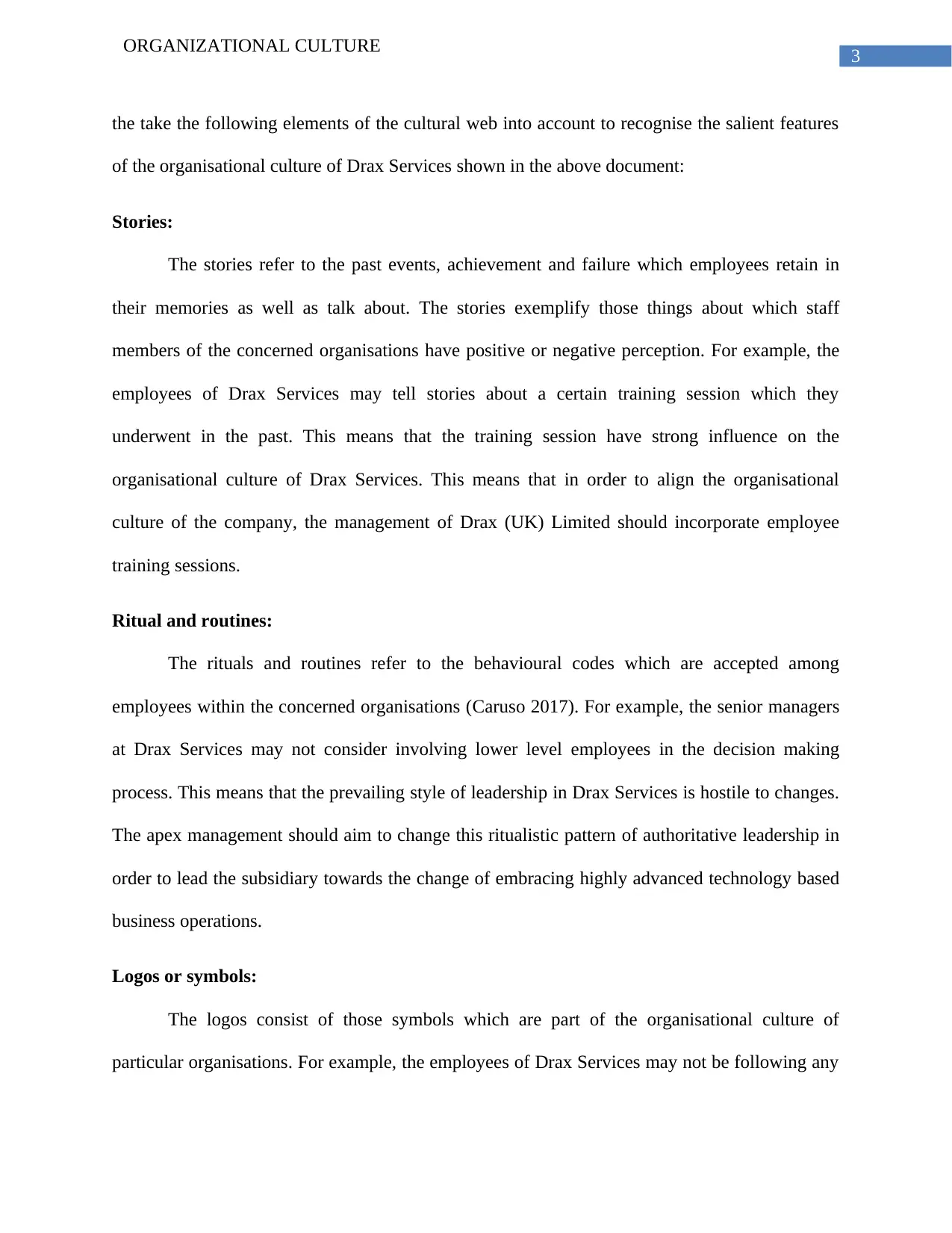
3
ORGANIZATIONAL CULTURE
the take the following elements of the cultural web into account to recognise the salient features
of the organisational culture of Drax Services shown in the above document:
Stories:
The stories refer to the past events, achievement and failure which employees retain in
their memories as well as talk about. The stories exemplify those things about which staff
members of the concerned organisations have positive or negative perception. For example, the
employees of Drax Services may tell stories about a certain training session which they
underwent in the past. This means that the training session have strong influence on the
organisational culture of Drax Services. This means that in order to align the organisational
culture of the company, the management of Drax (UK) Limited should incorporate employee
training sessions.
Ritual and routines:
The rituals and routines refer to the behavioural codes which are accepted among
employees within the concerned organisations (Caruso 2017). For example, the senior managers
at Drax Services may not consider involving lower level employees in the decision making
process. This means that the prevailing style of leadership in Drax Services is hostile to changes.
The apex management should aim to change this ritualistic pattern of authoritative leadership in
order to lead the subsidiary towards the change of embracing highly advanced technology based
business operations.
Logos or symbols:
The logos consist of those symbols which are part of the organisational culture of
particular organisations. For example, the employees of Drax Services may not be following any
ORGANIZATIONAL CULTURE
the take the following elements of the cultural web into account to recognise the salient features
of the organisational culture of Drax Services shown in the above document:
Stories:
The stories refer to the past events, achievement and failure which employees retain in
their memories as well as talk about. The stories exemplify those things about which staff
members of the concerned organisations have positive or negative perception. For example, the
employees of Drax Services may tell stories about a certain training session which they
underwent in the past. This means that the training session have strong influence on the
organisational culture of Drax Services. This means that in order to align the organisational
culture of the company, the management of Drax (UK) Limited should incorporate employee
training sessions.
Ritual and routines:
The rituals and routines refer to the behavioural codes which are accepted among
employees within the concerned organisations (Caruso 2017). For example, the senior managers
at Drax Services may not consider involving lower level employees in the decision making
process. This means that the prevailing style of leadership in Drax Services is hostile to changes.
The apex management should aim to change this ritualistic pattern of authoritative leadership in
order to lead the subsidiary towards the change of embracing highly advanced technology based
business operations.
Logos or symbols:
The logos consist of those symbols which are part of the organisational culture of
particular organisations. For example, the employees of Drax Services may not be following any
Paraphrase This Document
Need a fresh take? Get an instant paraphrase of this document with our AI Paraphraser
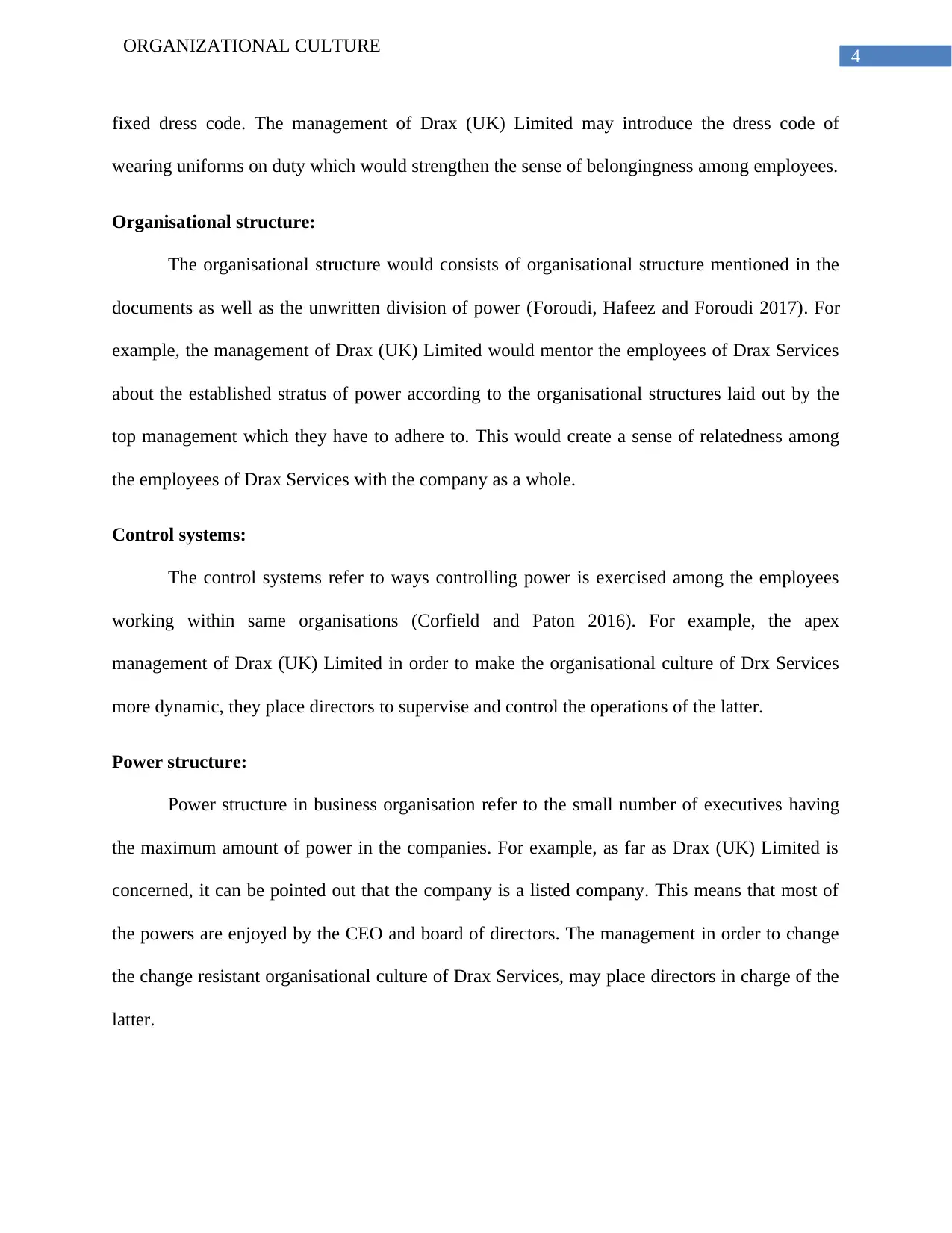
4
ORGANIZATIONAL CULTURE
fixed dress code. The management of Drax (UK) Limited may introduce the dress code of
wearing uniforms on duty which would strengthen the sense of belongingness among employees.
Organisational structure:
The organisational structure would consists of organisational structure mentioned in the
documents as well as the unwritten division of power (Foroudi, Hafeez and Foroudi 2017). For
example, the management of Drax (UK) Limited would mentor the employees of Drax Services
about the established stratus of power according to the organisational structures laid out by the
top management which they have to adhere to. This would create a sense of relatedness among
the employees of Drax Services with the company as a whole.
Control systems:
The control systems refer to ways controlling power is exercised among the employees
working within same organisations (Corfield and Paton 2016). For example, the apex
management of Drax (UK) Limited in order to make the organisational culture of Drx Services
more dynamic, they place directors to supervise and control the operations of the latter.
Power structure:
Power structure in business organisation refer to the small number of executives having
the maximum amount of power in the companies. For example, as far as Drax (UK) Limited is
concerned, it can be pointed out that the company is a listed company. This means that most of
the powers are enjoyed by the CEO and board of directors. The management in order to change
the change resistant organisational culture of Drax Services, may place directors in charge of the
latter.
ORGANIZATIONAL CULTURE
fixed dress code. The management of Drax (UK) Limited may introduce the dress code of
wearing uniforms on duty which would strengthen the sense of belongingness among employees.
Organisational structure:
The organisational structure would consists of organisational structure mentioned in the
documents as well as the unwritten division of power (Foroudi, Hafeez and Foroudi 2017). For
example, the management of Drax (UK) Limited would mentor the employees of Drax Services
about the established stratus of power according to the organisational structures laid out by the
top management which they have to adhere to. This would create a sense of relatedness among
the employees of Drax Services with the company as a whole.
Control systems:
The control systems refer to ways controlling power is exercised among the employees
working within same organisations (Corfield and Paton 2016). For example, the apex
management of Drax (UK) Limited in order to make the organisational culture of Drx Services
more dynamic, they place directors to supervise and control the operations of the latter.
Power structure:
Power structure in business organisation refer to the small number of executives having
the maximum amount of power in the companies. For example, as far as Drax (UK) Limited is
concerned, it can be pointed out that the company is a listed company. This means that most of
the powers are enjoyed by the CEO and board of directors. The management in order to change
the change resistant organisational culture of Drax Services, may place directors in charge of the
latter.
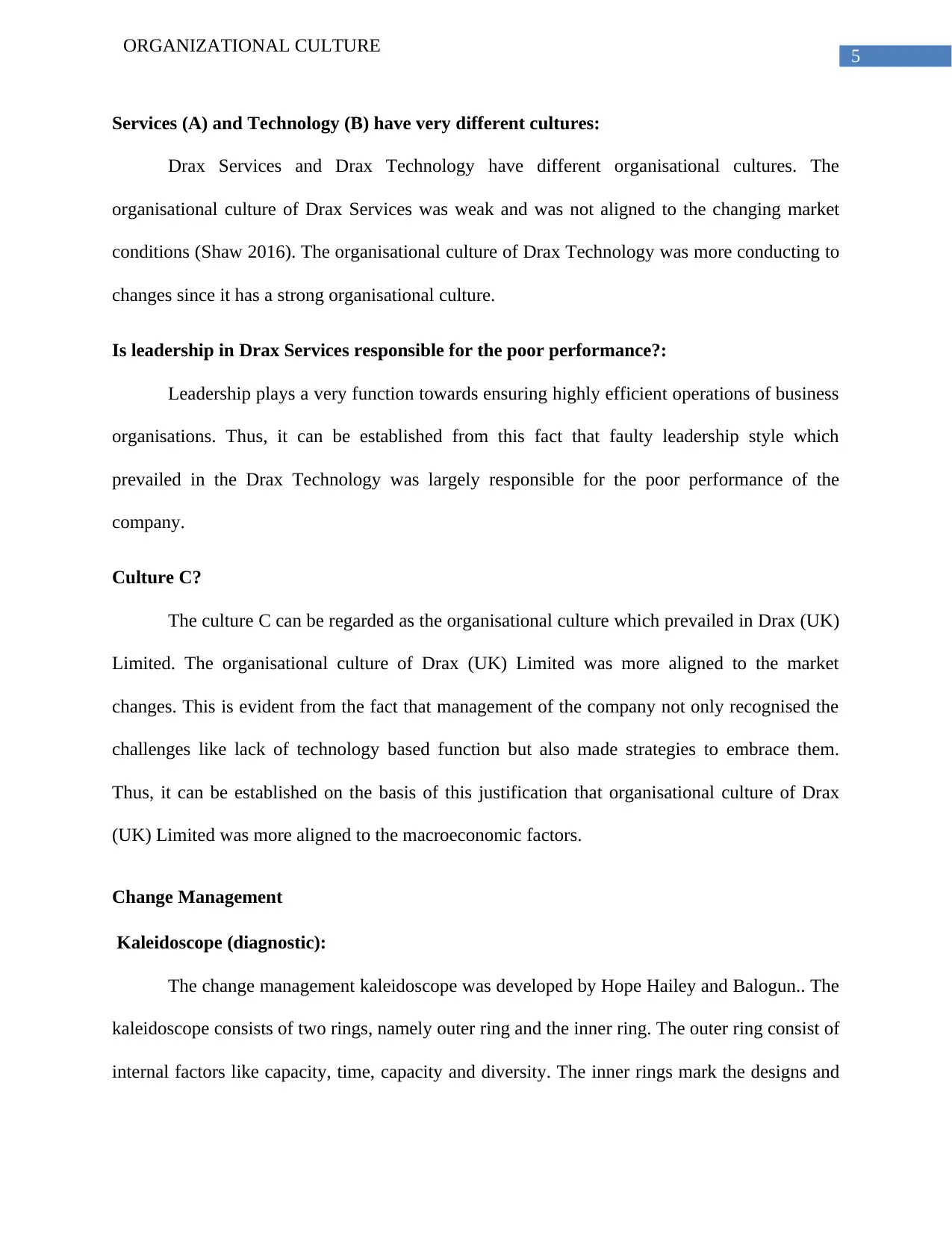
5
ORGANIZATIONAL CULTURE
Services (A) and Technology (B) have very different cultures:
Drax Services and Drax Technology have different organisational cultures. The
organisational culture of Drax Services was weak and was not aligned to the changing market
conditions (Shaw 2016). The organisational culture of Drax Technology was more conducting to
changes since it has a strong organisational culture.
Is leadership in Drax Services responsible for the poor performance?:
Leadership plays a very function towards ensuring highly efficient operations of business
organisations. Thus, it can be established from this fact that faulty leadership style which
prevailed in the Drax Technology was largely responsible for the poor performance of the
company.
Culture C?
The culture C can be regarded as the organisational culture which prevailed in Drax (UK)
Limited. The organisational culture of Drax (UK) Limited was more aligned to the market
changes. This is evident from the fact that management of the company not only recognised the
challenges like lack of technology based function but also made strategies to embrace them.
Thus, it can be established on the basis of this justification that organisational culture of Drax
(UK) Limited was more aligned to the macroeconomic factors.
Change Management
Kaleidoscope (diagnostic):
The change management kaleidoscope was developed by Hope Hailey and Balogun.. The
kaleidoscope consists of two rings, namely outer ring and the inner ring. The outer ring consist of
internal factors like capacity, time, capacity and diversity. The inner rings mark the designs and
ORGANIZATIONAL CULTURE
Services (A) and Technology (B) have very different cultures:
Drax Services and Drax Technology have different organisational cultures. The
organisational culture of Drax Services was weak and was not aligned to the changing market
conditions (Shaw 2016). The organisational culture of Drax Technology was more conducting to
changes since it has a strong organisational culture.
Is leadership in Drax Services responsible for the poor performance?:
Leadership plays a very function towards ensuring highly efficient operations of business
organisations. Thus, it can be established from this fact that faulty leadership style which
prevailed in the Drax Technology was largely responsible for the poor performance of the
company.
Culture C?
The culture C can be regarded as the organisational culture which prevailed in Drax (UK)
Limited. The organisational culture of Drax (UK) Limited was more aligned to the market
changes. This is evident from the fact that management of the company not only recognised the
challenges like lack of technology based function but also made strategies to embrace them.
Thus, it can be established on the basis of this justification that organisational culture of Drax
(UK) Limited was more aligned to the macroeconomic factors.
Change Management
Kaleidoscope (diagnostic):
The change management kaleidoscope was developed by Hope Hailey and Balogun.. The
kaleidoscope consists of two rings, namely outer ring and the inner ring. The outer ring consist of
internal factors like capacity, time, capacity and diversity. The inner rings mark the designs and
⊘ This is a preview!⊘
Do you want full access?
Subscribe today to unlock all pages.

Trusted by 1+ million students worldwide
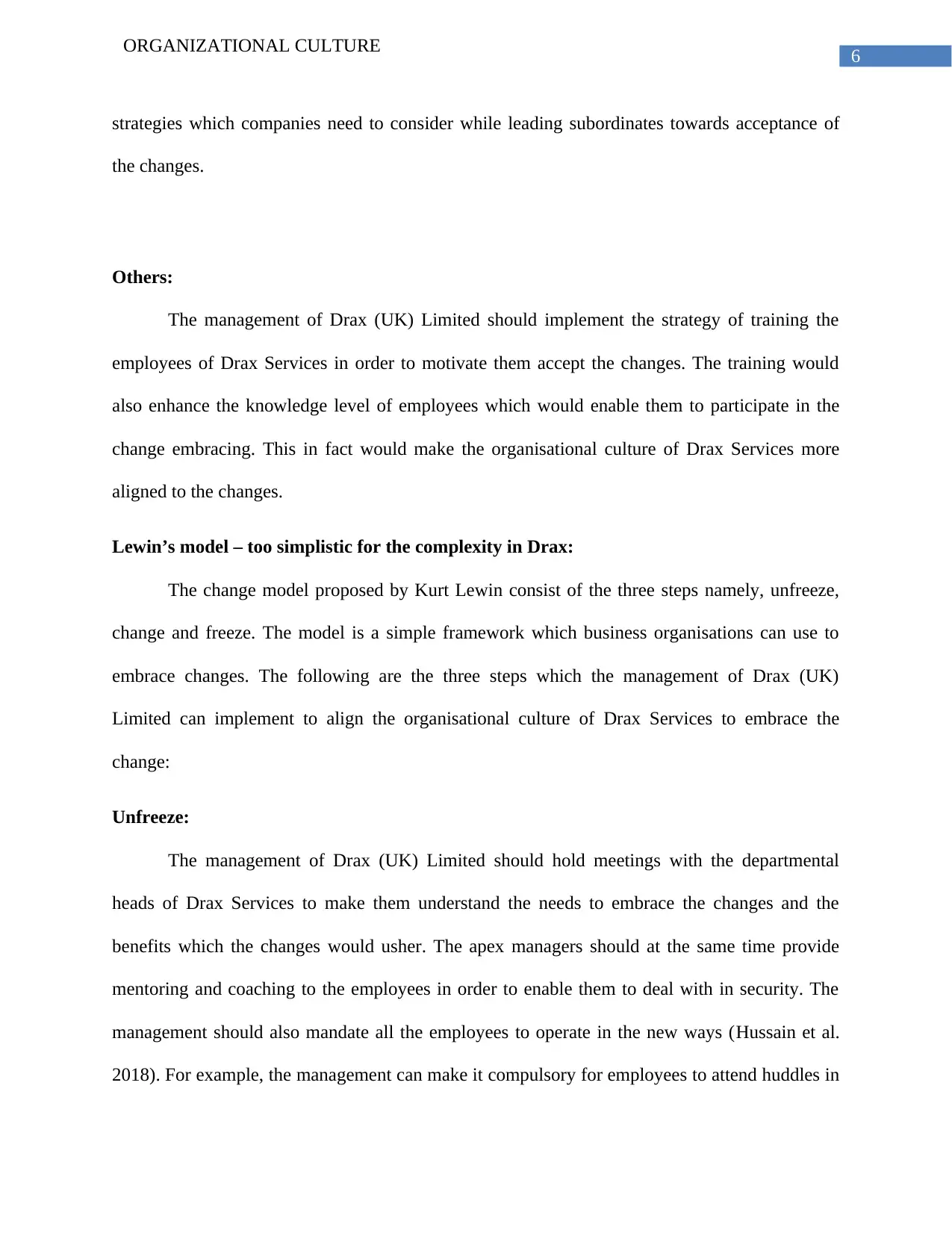
6
ORGANIZATIONAL CULTURE
strategies which companies need to consider while leading subordinates towards acceptance of
the changes.
Others:
The management of Drax (UK) Limited should implement the strategy of training the
employees of Drax Services in order to motivate them accept the changes. The training would
also enhance the knowledge level of employees which would enable them to participate in the
change embracing. This in fact would make the organisational culture of Drax Services more
aligned to the changes.
Lewin’s model – too simplistic for the complexity in Drax:
The change model proposed by Kurt Lewin consist of the three steps namely, unfreeze,
change and freeze. The model is a simple framework which business organisations can use to
embrace changes. The following are the three steps which the management of Drax (UK)
Limited can implement to align the organisational culture of Drax Services to embrace the
change:
Unfreeze:
The management of Drax (UK) Limited should hold meetings with the departmental
heads of Drax Services to make them understand the needs to embrace the changes and the
benefits which the changes would usher. The apex managers should at the same time provide
mentoring and coaching to the employees in order to enable them to deal with in security. The
management should also mandate all the employees to operate in the new ways (Hussain et al.
2018). For example, the management can make it compulsory for employees to attend huddles in
ORGANIZATIONAL CULTURE
strategies which companies need to consider while leading subordinates towards acceptance of
the changes.
Others:
The management of Drax (UK) Limited should implement the strategy of training the
employees of Drax Services in order to motivate them accept the changes. The training would
also enhance the knowledge level of employees which would enable them to participate in the
change embracing. This in fact would make the organisational culture of Drax Services more
aligned to the changes.
Lewin’s model – too simplistic for the complexity in Drax:
The change model proposed by Kurt Lewin consist of the three steps namely, unfreeze,
change and freeze. The model is a simple framework which business organisations can use to
embrace changes. The following are the three steps which the management of Drax (UK)
Limited can implement to align the organisational culture of Drax Services to embrace the
change:
Unfreeze:
The management of Drax (UK) Limited should hold meetings with the departmental
heads of Drax Services to make them understand the needs to embrace the changes and the
benefits which the changes would usher. The apex managers should at the same time provide
mentoring and coaching to the employees in order to enable them to deal with in security. The
management should also mandate all the employees to operate in the new ways (Hussain et al.
2018). For example, the management can make it compulsory for employees to attend huddles in
Paraphrase This Document
Need a fresh take? Get an instant paraphrase of this document with our AI Paraphraser
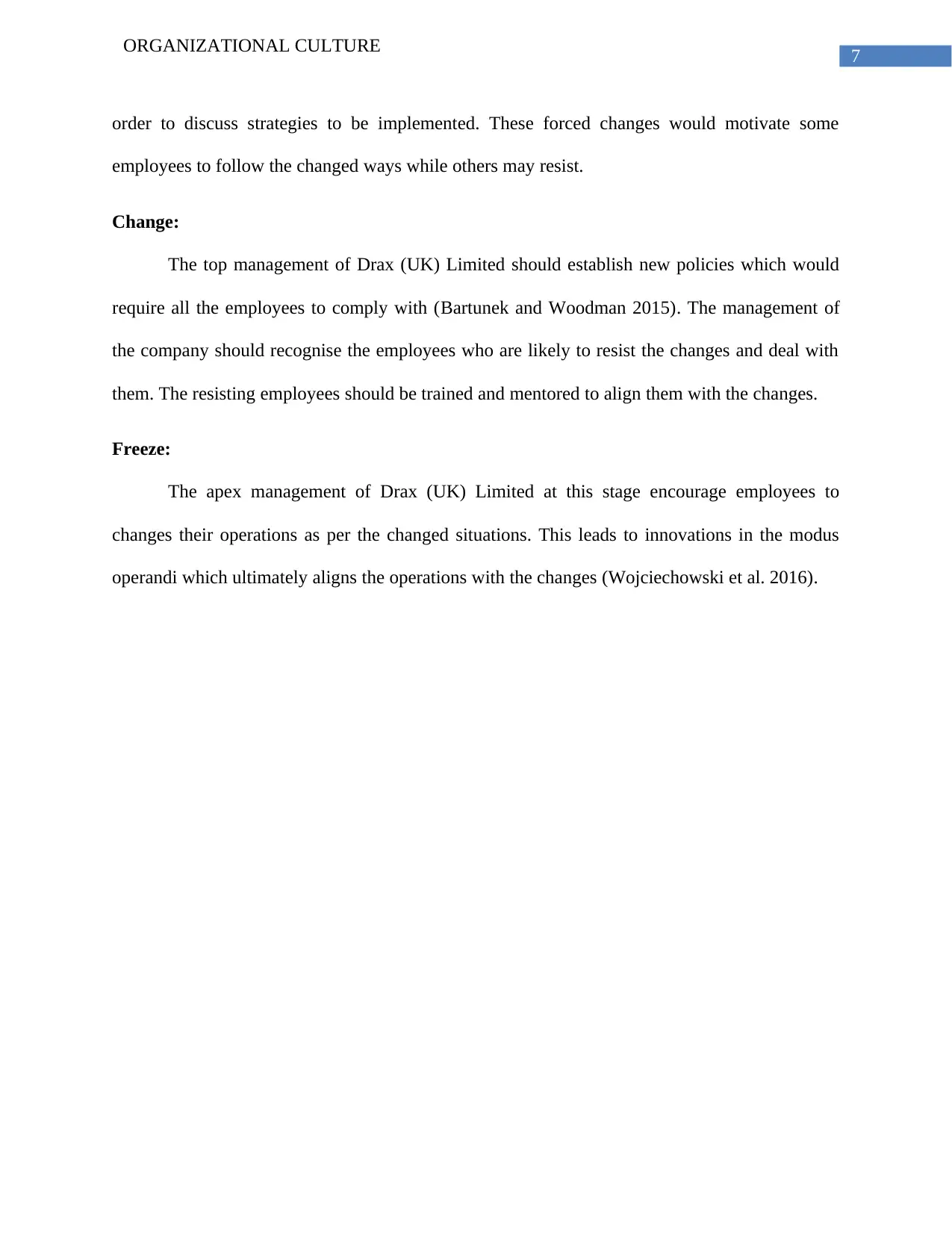
7
ORGANIZATIONAL CULTURE
order to discuss strategies to be implemented. These forced changes would motivate some
employees to follow the changed ways while others may resist.
Change:
The top management of Drax (UK) Limited should establish new policies which would
require all the employees to comply with (Bartunek and Woodman 2015). The management of
the company should recognise the employees who are likely to resist the changes and deal with
them. The resisting employees should be trained and mentored to align them with the changes.
Freeze:
The apex management of Drax (UK) Limited at this stage encourage employees to
changes their operations as per the changed situations. This leads to innovations in the modus
operandi which ultimately aligns the operations with the changes (Wojciechowski et al. 2016).
ORGANIZATIONAL CULTURE
order to discuss strategies to be implemented. These forced changes would motivate some
employees to follow the changed ways while others may resist.
Change:
The top management of Drax (UK) Limited should establish new policies which would
require all the employees to comply with (Bartunek and Woodman 2015). The management of
the company should recognise the employees who are likely to resist the changes and deal with
them. The resisting employees should be trained and mentored to align them with the changes.
Freeze:
The apex management of Drax (UK) Limited at this stage encourage employees to
changes their operations as per the changed situations. This leads to innovations in the modus
operandi which ultimately aligns the operations with the changes (Wojciechowski et al. 2016).
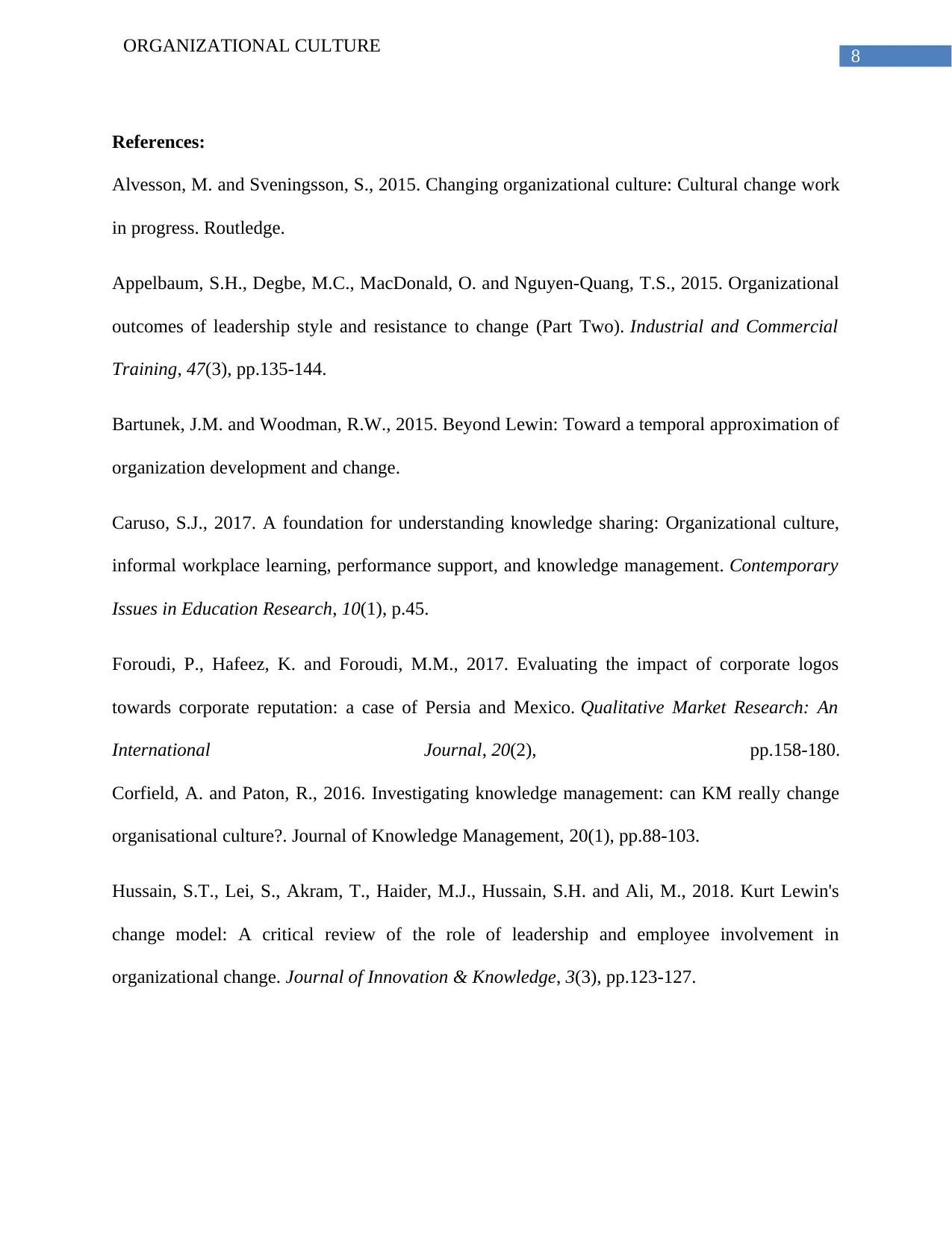
8
ORGANIZATIONAL CULTURE
References:
Alvesson, M. and Sveningsson, S., 2015. Changing organizational culture: Cultural change work
in progress. Routledge.
Appelbaum, S.H., Degbe, M.C., MacDonald, O. and Nguyen-Quang, T.S., 2015. Organizational
outcomes of leadership style and resistance to change (Part Two). Industrial and Commercial
Training, 47(3), pp.135-144.
Bartunek, J.M. and Woodman, R.W., 2015. Beyond Lewin: Toward a temporal approximation of
organization development and change.
Caruso, S.J., 2017. A foundation for understanding knowledge sharing: Organizational culture,
informal workplace learning, performance support, and knowledge management. Contemporary
Issues in Education Research, 10(1), p.45.
Foroudi, P., Hafeez, K. and Foroudi, M.M., 2017. Evaluating the impact of corporate logos
towards corporate reputation: a case of Persia and Mexico. Qualitative Market Research: An
International Journal, 20(2), pp.158-180.
Corfield, A. and Paton, R., 2016. Investigating knowledge management: can KM really change
organisational culture?. Journal of Knowledge Management, 20(1), pp.88-103.
Hussain, S.T., Lei, S., Akram, T., Haider, M.J., Hussain, S.H. and Ali, M., 2018. Kurt Lewin's
change model: A critical review of the role of leadership and employee involvement in
organizational change. Journal of Innovation & Knowledge, 3(3), pp.123-127.
ORGANIZATIONAL CULTURE
References:
Alvesson, M. and Sveningsson, S., 2015. Changing organizational culture: Cultural change work
in progress. Routledge.
Appelbaum, S.H., Degbe, M.C., MacDonald, O. and Nguyen-Quang, T.S., 2015. Organizational
outcomes of leadership style and resistance to change (Part Two). Industrial and Commercial
Training, 47(3), pp.135-144.
Bartunek, J.M. and Woodman, R.W., 2015. Beyond Lewin: Toward a temporal approximation of
organization development and change.
Caruso, S.J., 2017. A foundation for understanding knowledge sharing: Organizational culture,
informal workplace learning, performance support, and knowledge management. Contemporary
Issues in Education Research, 10(1), p.45.
Foroudi, P., Hafeez, K. and Foroudi, M.M., 2017. Evaluating the impact of corporate logos
towards corporate reputation: a case of Persia and Mexico. Qualitative Market Research: An
International Journal, 20(2), pp.158-180.
Corfield, A. and Paton, R., 2016. Investigating knowledge management: can KM really change
organisational culture?. Journal of Knowledge Management, 20(1), pp.88-103.
Hussain, S.T., Lei, S., Akram, T., Haider, M.J., Hussain, S.H. and Ali, M., 2018. Kurt Lewin's
change model: A critical review of the role of leadership and employee involvement in
organizational change. Journal of Innovation & Knowledge, 3(3), pp.123-127.
⊘ This is a preview!⊘
Do you want full access?
Subscribe today to unlock all pages.

Trusted by 1+ million students worldwide
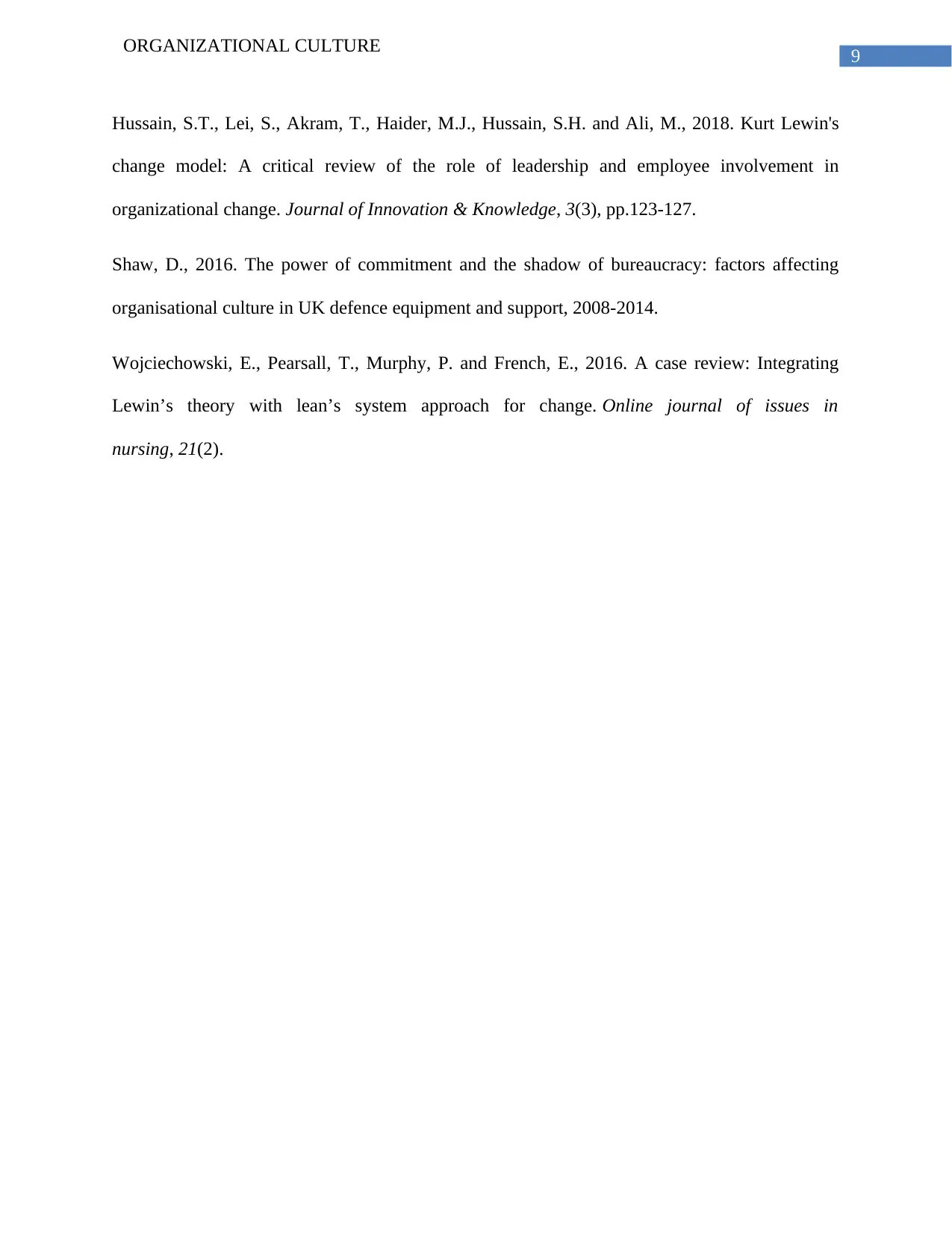
9
ORGANIZATIONAL CULTURE
Hussain, S.T., Lei, S., Akram, T., Haider, M.J., Hussain, S.H. and Ali, M., 2018. Kurt Lewin's
change model: A critical review of the role of leadership and employee involvement in
organizational change. Journal of Innovation & Knowledge, 3(3), pp.123-127.
Shaw, D., 2016. The power of commitment and the shadow of bureaucracy: factors affecting
organisational culture in UK defence equipment and support, 2008-2014.
Wojciechowski, E., Pearsall, T., Murphy, P. and French, E., 2016. A case review: Integrating
Lewin’s theory with lean’s system approach for change. Online journal of issues in
nursing, 21(2).
ORGANIZATIONAL CULTURE
Hussain, S.T., Lei, S., Akram, T., Haider, M.J., Hussain, S.H. and Ali, M., 2018. Kurt Lewin's
change model: A critical review of the role of leadership and employee involvement in
organizational change. Journal of Innovation & Knowledge, 3(3), pp.123-127.
Shaw, D., 2016. The power of commitment and the shadow of bureaucracy: factors affecting
organisational culture in UK defence equipment and support, 2008-2014.
Wojciechowski, E., Pearsall, T., Murphy, P. and French, E., 2016. A case review: Integrating
Lewin’s theory with lean’s system approach for change. Online journal of issues in
nursing, 21(2).
1 out of 10
Related Documents
Your All-in-One AI-Powered Toolkit for Academic Success.
+13062052269
info@desklib.com
Available 24*7 on WhatsApp / Email
![[object Object]](/_next/static/media/star-bottom.7253800d.svg)
Unlock your academic potential
Copyright © 2020–2025 A2Z Services. All Rights Reserved. Developed and managed by ZUCOL.




